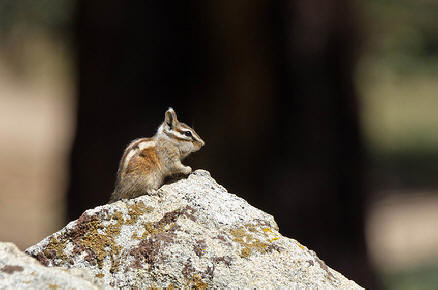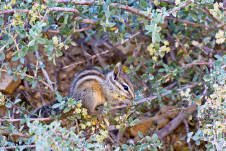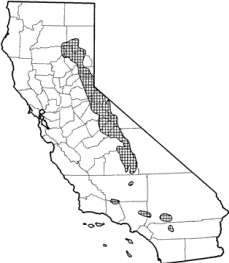Tamias speciosus callipeplus
- Sensitive – U.S. Forest Service

Lodgepole chipmunk. Photo courtesy of Lee Hoy | Big Bend Birding & Photo Tours
The Mount Pinos lodgepole chipmunk is a subspecies of chipmunk found only on the upper slopes and summits of Mount Pinos, Cerro Noreste, and Frazier Mountain in the Los Padres National Forest near the Kern/Ventura county line. Because of its isolated population, the Forest Service has classified the Mount Pinos lodgepole chipmunk as a Sensitive Species, and the California Department of Fish & Game has classified it as a “species of special concern.”
There are four subspecies of lodgepole chipmunk (Tamias speciosus) in California, so named because they are common in forests containing lodgepole pines. Two of the subspecies are found in northern and central California, and the other two – including the Mount Pinos lodgepole chipmunk – occur in southern portions of the state. The Mount Pinos lodgepole chipmunk is an isolated subspecies and does not overlap in range with any of the other lodgepole chipmunk subspecies. They are highly aggressive towards other chipmunks outside their species, but they only overlap with the Merriam’s chipmunk and are often found in different habitat types, keeping the potential for battle low.
Habitat
Mount Pinos lodgepole chipmunks are primarily found around old logs, rock outcroppings and other forest debris. Rock crevasses and old logs are required for protection from predators (coyote, foxes, bobcat, Cooper’s hawk, and red-tailed hawk) and are used as nesting sites. Trees are also an important habitat component – the lodgepole chipmunks are perhaps the best climbers of any of the chipmunks and they readily use trees as an escape route. Occasionally an existing cavity may be used as a nesting site, but more often nests are concealed under rocks or in rock crevasses.
Hibernation & Breeding
The lodgepole chipmunk enters hibernation in late October/early November, waking every 1-2 days near the beginning and end of hibernation, but remaining dormant for longer periods (5-6 days) during the remainder of their hibernation. Their breeding season occurs in May and June, about one month after emerging from hibernation. They produce one litter per year, and the number of young ranges from three to six.

Photo courtesy of Lee Hoy | Big Bend Birding & Photo Tours
Mmm…Fungus, Delicious!
Lodgepole chipmunks are active during the day, though a bit skittish and secretive. They are generally arboreal, using trees for refuge and as observation posts. There is little information on the diet of the Mount Pinos subspecies, but lodgepole chipmunks in other parts of the state are generally omnivorous, eating seeds of grasses, forbs, and trees; fruits and berries; insects; picnic scraps; and carrion. Lodgepole chipmunks also eat fungi, which comprises 32 percent of the annual dietary volume! During summer and autumn, in preparation for hibernation, lodgepole chipmunks devote much of their time to gathering food, collecting it in external cheek pouches and later storing it beneath old logs, in rock piles, and in forks and foliage of trees.
Threats
The population status of this cute critter is presently unknown. The Forest Service has recommended field studies to verify the population status and better understand habitat preferences. Because the Mt. Pinos lodgepole chipmunk is an isolated subspecies with a very limited distribution, threats include but are not necessarily limited to: vacation home development, improperly managed recreational activities, logging of habitat, prescribed burns and large-scale wildfire, according to the Forest Service.
ForestWatch will carefully evaluate proposed projects in the area the Mt. Pinos lodgepole chipmunk calls home, working to protect this important species.







